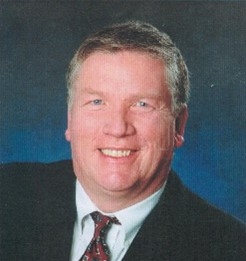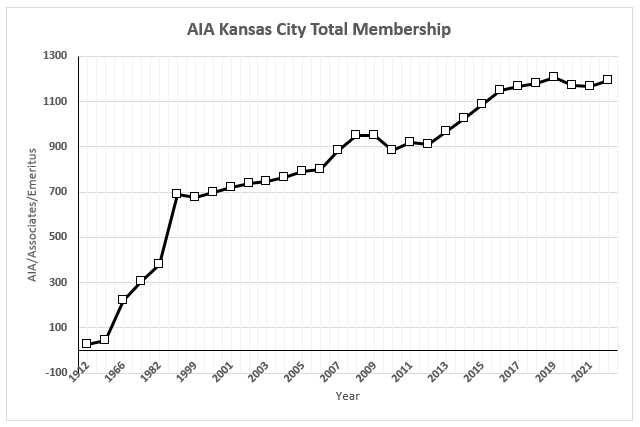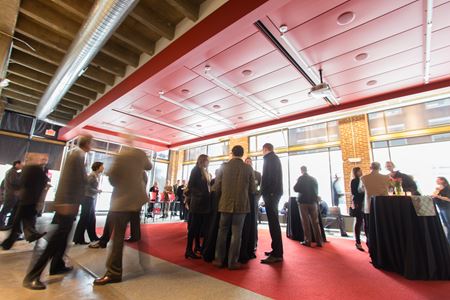Chapter History
 Roots of our local chapter can be traced to 1882, when Kansas City was a small town of 55,000 citizens. In an article published in The Southern Architect, Ben J. Lubschez, AIA, noted the formation of the Kansas City Society of Architects. In October 1890, the Society reorganized as the Kansas City Chapter of the American Institute of Architects, which was incorporated nationally in 1857.
Roots of our local chapter can be traced to 1882, when Kansas City was a small town of 55,000 citizens. In an article published in The Southern Architect, Ben J. Lubschez, AIA, noted the formation of the Kansas City Society of Architects. In October 1890, the Society reorganized as the Kansas City Chapter of the American Institute of Architects, which was incorporated nationally in 1857.
In 1899, Henry Van Brunt, FAIA, was elected national president of the AIA, the first president from west of the Mississippi.
The Kansas City chapter struggled for members, and by 1911 had only 25 members. Younger members took the initiative to recruit architects and by 1912, the chapter had 43 members. The profession was affected along with the rest of the nation by the Great Depression of the 1930s. The main thrust of the industry was public work through the WPA. Many firms in the area closed or dwindled to skeleton staff to handle the work available. Architects of this era were involved with World Wars I and II or opened offices at major defense locations. The end of World War II led to a major influx in construction and architecture graduates. AIA membership increased dramatically both nationally and locally by 1950.
In 1930 Elizabeth Rivard, a Kansas City architect, the first woman to graduate with honors from the University of Kansas architecture program, received an AIA Kansas City Design Award. It was reported that the chapter informed her that by using her initials they did not know she was a woman, and that she would probably not have received the award with full disclosure.
 As reported by Larry Horning, a major event in the history of the Chapter was the voluntary collaboration with the City Plan Commission in the development of the master plan of the Central Business District, later lo be known as KC-80. The effort started in1957 as the result of discussions between Planning Commission member Clarence Kivett, FAIA, and Chief City Planner Phil Geissel. M Dwight Brown, FAIA, appointed a special design committee that included: chair John Murphy, FAIA; David Runnels; Homer Neville; Ralph Meyers, FAIA; Word Haylett; and Jack Morley.
As reported by Larry Horning, a major event in the history of the Chapter was the voluntary collaboration with the City Plan Commission in the development of the master plan of the Central Business District, later lo be known as KC-80. The effort started in1957 as the result of discussions between Planning Commission member Clarence Kivett, FAIA, and Chief City Planner Phil Geissel. M Dwight Brown, FAIA, appointed a special design committee that included: chair John Murphy, FAIA; David Runnels; Homer Neville; Ralph Meyers, FAIA; Word Haylett; and Jack Morley.
Thousands of volunteer hours by many members went into an elaborate plan which resulted in numerous Chapter presentations all over the country. A Citation of Honor was bestowed upon the Kansas City Chapter for the KC-80 program at the National AIA convention in1959. This cooperative effort gave the Chapter an impetus for growth and activity that continued for many years.
AIA Kansas City began to mature and cultivate progressive forms of communicating. The most noteworthy example of this was the development of the monthly publication Skylines during the presidency of Joseph Shaughnessy, Sr., AIA. It was edited by Frank Grimaldi, AIA. Skylines became the voice of our Chapter until the early 1970's. Skylines then merged with the Missouri Council of Architects publication The Midwest Architect and was produced until the latter part of that decade. You can view all the past issues of Skylines here. During the 1990’s Skylines was replaced by a monthly newsletter Exchange, edited by Kevin Harden, AIA.
In 1954, the AIA Kansas City was incorporated and established a permanent office with a half-time secretary. Gerre Jones began as the first full-time Executive Secretary in 1959 and stayed with the Chapter for four years. Subsequent Executive Secretaries included Dorothy Lamonee, Robin M. League, and Betty Brooker. In 1953, Betty Brooker was reported to have become the Chapter's first female member, joining as a junior associate with the firm of Voskamp and Slezak.
 A major event in the Chapter came with the hiring of Linda Young, Hon. AIA, as Executive Director in 1977. Her continuous energy and enthusiasm in the ensuing twelve years carried over to the ever-expanding programs and services. The chapter has been very fortunate to have two outstanding executives to follow Linda – Dawn Kirkwood and Dawn Taylor.
A major event in the Chapter came with the hiring of Linda Young, Hon. AIA, as Executive Director in 1977. Her continuous energy and enthusiasm in the ensuing twelve years carried over to the ever-expanding programs and services. The chapter has been very fortunate to have two outstanding executives to follow Linda – Dawn Kirkwood and Dawn Taylor.
During the 70’s the chapter was active at a local and national level. In 1979, AIA Kansas City hosted the AIA Convention. As part of the convention activities the chapter sponsored a RUDAT (Regional Urban Design Assistance Team) study. Revenue from the convention was used in 1982 to create the Kansas City Architectural Foundation, a separate 501 c(3) charitable organization. The foundation has supported several initiatives in collaboration with the Chapter, including support for Dean and Ginny Graves’ CUBE educational initiative, Urban Design Awards co-sponsorship. In 1991, KCAF began awarding annual student scholarships.

 During the 1980s, Vernon Reed, FAIA, spearheaded AIA actions to provide architects copyright protections for design. In 1985, R. Bruce Patty, FAIA, was elected national president of the American Institute of Architects. Homer Williams, FAIA, served as president of NCARB in 1994-95. Frank Zilm, FAIA, also served as president of the AIA Academy on Architecture for Health. Many AIA members served on local civic initiatives.
During the 1980s, Vernon Reed, FAIA, spearheaded AIA actions to provide architects copyright protections for design. In 1985, R. Bruce Patty, FAIA, was elected national president of the American Institute of Architects. Homer Williams, FAIA, served as president of NCARB in 1994-95. Frank Zilm, FAIA, also served as president of the AIA Academy on Architecture for Health. Many AIA members served on local civic initiatives.
In the early 1990s through the leadership of Bob Berkebile, FAIA, and Kirk Gastinger, FAIA, the chapter became a local, national, and international leader in advocacy for the environment. Multiple initiatives, including the Green Building Council, the AIA Committee on the Environment, and other initiatives have their roots in AIA Kansas City leadership. At the local level, the chapter recently advocated for the Kansas City Climate Action Plan and the adoptions of the 2021 IECC energy code.
In 2000, AIA Kansas City published Guide to Kansas City Architecture and Public Art. Members also supported other publications regarding Kansas City architecture, including A City Within a Park, Stalking Louis Curtis, and George Ehrlich’s An Architectural History, 1826-1976.
William Henry Johnson, AIA, became one of the first African American members in 1965.
In 1996 Vicki Noteis, AIA, served as the first female president of the chapter. Since Vicki's chapter presidency, six women have served as AIA Kansas City President: Kathy Burke, AIA, Susan Richards Johnson, AIA, Sonya Jury, AIA, Laura Lesniewski, FAIA, Marsha Hoffman, AIA, and Amy Eckhoff, AIA.
In 1988, the chapter moved from the New York Life building to a larger space in the adjacent Lyceum Theater at the Stillwell building. The Chapter moved into 1801 McGee in December 2009. Staff expanded to 4 full-time employees in June 2012.
In 2010, the chapter initiated in a joint venture with AIGA KC to host KC Design Week, a series of events and programs celebrating design. In 2015, the chapter joined with six other organizations to form the Center for Architecture & Design, a nonprofit organization bringing design inpiration, programming, and awareness to Kansas City.
While Kansas City is the 30th largest standard metropolitan statistical area in the United States, AIA Kansas City is the 17th largest local chapter in the AIA.

[1] Material used for this article include a 1912 article by Ben J. Lubschez in the Southern Architect and an article in AIA KC Exchange by Larry Horning.



